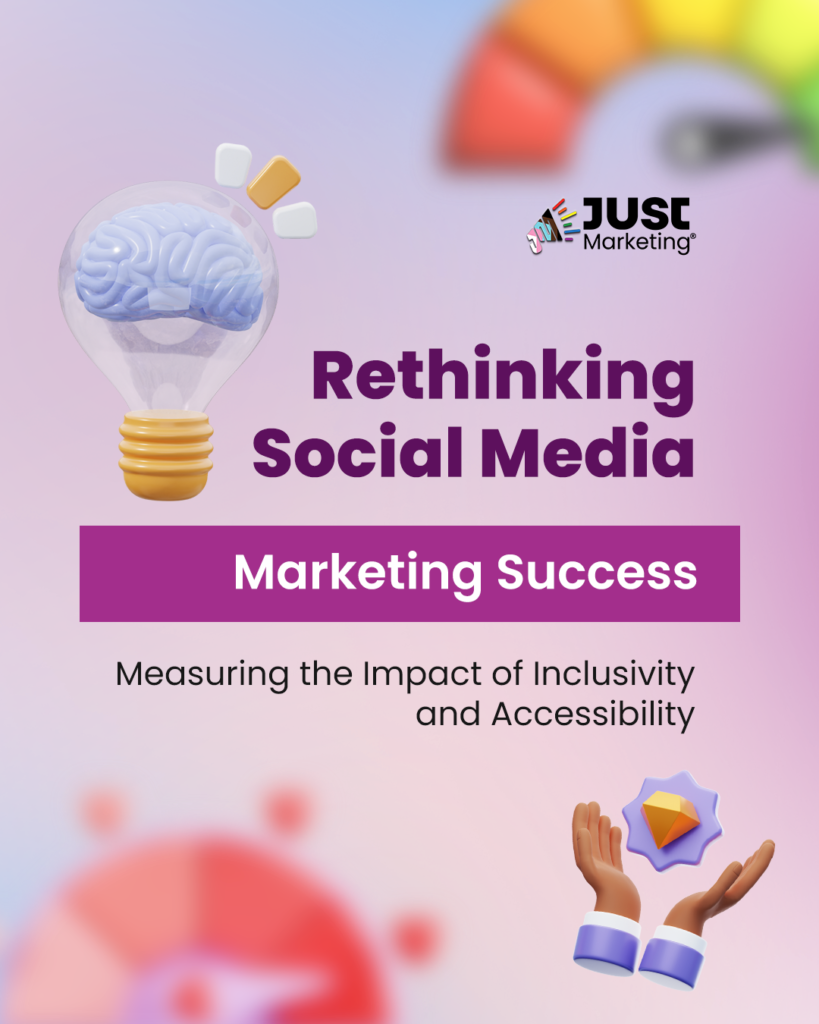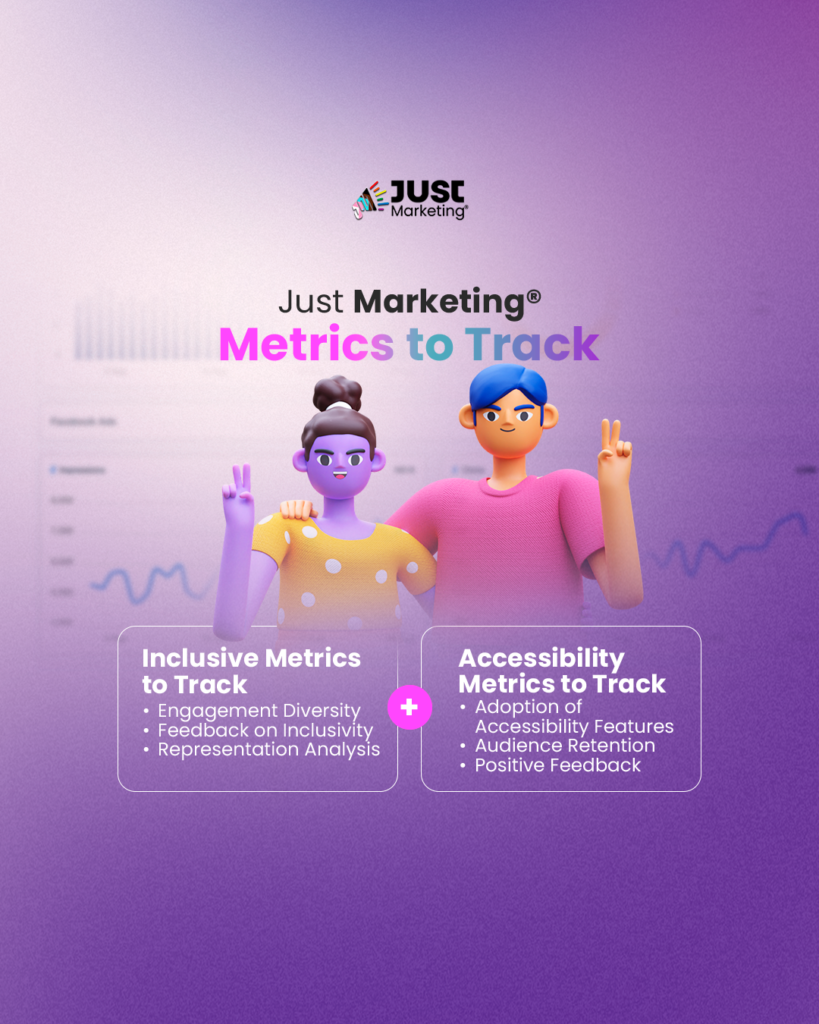In the world of social media marketing, it’s easy to get swept up in the race for likes, shares, and followers. These so-called “vanity metrics” dominate dashboards and strategy meetings, convincing us that bigger numbers always mean better results. But do they really tell the full story?
For mission-driven entrepreneurs and small businesses, success isn’t just about reach – it’s about resonance. It’s about creating meaningful connections with your audience, ensuring your content is accessible to everyone, and reflecting the inclusivity you value in your business. When we prioritize numbers over people, we risk alienating the very communities we aim to serve.
This blog is your guide to rethinking success in social media marketing. We’ll explore why traditional metrics fall short, how inclusivity and accessibility create deeper impact, and what you can measure instead to align your marketing with your mission. Let’s go beyond the numbers and uncover a better way to define success.
The Problem with Traditional Metrics
When it comes to evaluating social media success, metrics like likes, shares, and follower counts often steal the spotlight. These “vanity metrics” are easy to track and gratifying to see grow – but do they actually reflect meaningful progress?

The truth is, vanity metrics only tell part of the story. Here’s why they fall short:
1. They Prioritize Quantity Over Quality
Vanity metrics measure surface-level engagement without revealing whether your audience is truly connected to your brand. A post might get hundreds of likes, but how many of those people are your ideal clients? How many took meaningful action – like visiting your website, signing up for your email list, or reaching out to learn more?
2. They Don’t Reflect Your Values
For businesses driven by justice, equity, diversity, and inclusion, success is about more than numbers. A million followers mean little if your content isn’t inclusive or accessible. Worse, chasing metrics can unintentionally lead to exclusionary practices, like ignoring accessibility features or defaulting to content that appeals to mainstream audiences rather than underrepresented groups.
3. They Encourage Performative Content
When numbers are the goal, it’s tempting to prioritize what will “go viral” over what aligns with your mission. This can lead to inauthentic or performative content that undermines your brand’s credibility and connection with your audience.
4. They Contribute to Burnout
The pressure to constantly grow your numbers can be exhausting, especially for neurodiverse entrepreneurs or small business owners juggling multiple roles. Social media starts to feel like a hamster wheel, leaving little room for creativity, innovation, or the deeper connections that truly matter.
The Cost of Focusing on the Wrong Metrics
When you measure success by metrics that don’t align with your mission, you risk losing sight of what truly matters: building a community that reflects your values, supports your goals, and amplifies your impact. The result? A social media presence that feels hollow – both to you and to your audience.
It’s time to rethink what success means in social media marketing. Next, we’ll explore how shifting your focus from vanity metrics to values-driven impact can transform the way you measure – and achieve – success.
Rethinking Success in Social Media Marketing
If vanity metrics don’t tell the full story, what does success look like in a social media strategy driven by inclusivity, accessibility, and authentic connections? It’s time to redefine success in terms that go beyond numbers and resonate with your values and mission.

Values Over Virality
True social media success isn’t about how many people see your content – it’s about how your content makes people feel and what it inspires them to do. A smaller, engaged audience that aligns with your values can have far more impact than a massive following with little connection to your brand.
Ask yourself:
- Does your content reflect your commitment to inclusivity and accessibility?
- Are you creating value for your audience, or just aiming for visibility?
- Do your interactions online mirror the respect and thoughtfulness your brand stands for?
Focus Areas for Inclusive Success
To build a social media strategy that aligns with your mission, prioritize these aspects:
- Quality of Engagement: Instead of counting likes, look for meaningful comments and conversations. Are people asking thoughtful questions, sharing their own experiences, or showing genuine interest in your work?
- Representation: Evaluate whether your content reflects diverse voices, perspectives, and stories. This includes featuring diverse imagery, amplifying underrepresented voices, and avoiding tokenism.
- Audience Alignment: Who is engaging with your content? Focus on attracting followers who resonate with your mission, values, and offerings, even if the numbers are smaller.
The Ripple Effect of Inclusivity and Accessibility
An inclusive, accessible approach to social media creates a ripple effect:
- It fosters trust and loyalty among your audience.
- It helps you stand out as a brand committed to ethical practices.
- It encourages others in your industry to prioritize inclusivity and accessibility, amplifying the impact of your efforts.
By redefining success, you can create a social media strategy that not only works but feels good to you and your audience.
Measuring Inclusivity and Accessibility
Once you’ve redefined social media success to focus on inclusivity and accessibility, the next step is figuring out how to measure your impact. While traditional metrics may still play a role, they’re no longer the sole indicator of your progress. Instead, we’re looking for metrics and methods that reflect your values and resonate with your mission.
Tracking inclusivity and accessibility ensures that your marketing aligns with your values and helps you identify areas for improvement. It’s not just about checking boxes; it’s about creating meaningful experiences for your audience and fostering a sense of belonging.

Inclusive Metrics to Track
These metrics focus on the diversity and inclusivity of your content and engagement:
- Engagement Diversity: Are you receiving engagement (comments, likes, shares) from a range of people, including those from underrepresented groups?
- Feedback on Inclusivity: Are people acknowledging your efforts to be inclusive in comments or direct messages? You might hear, “This post really spoke to me,” or “Thank you for representing my experience.”
- Representation Analysis: Look at your content library. Does it feature diverse voices, perspectives, and imagery? Tools like content audits can help identify gaps.
Accessibility Metrics to Track
Accessibility ensures your content can be enjoyed by everyone, regardless of ability. Key metrics include:
- Adoption of Accessibility Features: Are you consistently adding alt text to images, captions to videos, and ensuring readable color contrast?
- Audience Retention: For videos or long-form content, are people staying engaged? A drop-off may indicate accessibility issues.
- Positive Feedback: Do followers share that they appreciate your accessible practices? A simple “Thanks for using captions!” is a win.
Tools and Methods for Tracking
While some metrics can be tracked directly within social platforms, others require qualitative approaches:
- Analytics Platforms: Tools like Google Analytics, social media insights, or third-party apps (e.g., Sprout Social) can provide data on audience demographics, behavior, and retention.
- Surveys and Polls: Ask your audience directly about their experiences. Questions like, “How accessible do you find our content?” or “What can we improve to make our content more inclusive?” can yield valuable insights.
- Focus Groups: Engage a small group of your audience for deeper discussions on how they perceive your content’s inclusivity and accessibility.
- Content Audits: Regularly review your social media content to ensure you’re meeting accessibility standards and representing diverse voices.
While these metrics provide insight, remember to balance measurement with intention. Inclusivity and accessibility are long-term commitments that can’t always be quantified in the short term. Celebrate small wins, and stay focused on continuous improvement.
By tracking inclusivity and accessibility, you gain more than data – you gain clarity on how your social media efforts align with your mission.
Ethical and Practical Strategies for Improvement
Measuring inclusivity and accessibility is a crucial step, but how do you ensure your social media strategy consistently reflects these values?

Ethical Commitments to Guide Your Approach
Inclusivity and accessibility are ongoing commitments. Here are ways to stay aligned with your values:
- Be Transparent: Share your process for creating accessible and inclusive content. Acknowledge missteps and commit to doing better.
- Avoid Performative Actions: Inclusivity isn’t a trend – it’s a practice. Ensure your efforts are genuine and not just for show.
- Amplify Others: Use your platform to elevate voices from underrepresented communities, giving credit where it’s due.
Steps to Foster Inclusivity
Inclusivity isn’t just about representation – it’s about fostering connection and belonging. Here’s how to incorporate it into your strategy:
- Feature Diverse Voices: Share stories, quotes, or collaborations from people of different backgrounds, abilities, and experiences. Avoid tokenism by centering these voices authentically.
- Use Inclusive Language:
- Avoid gendered terms when unnecessary (e.g., say “folks” or “everyone” instead of “guys”).
- Be mindful of idioms or phrases that might exclude or alienate certain groups.
- Engage Your Audience: Ask questions that encourage diverse perspectives and show you value their input. For example: “What does inclusivity mean to you?”
- Audit Representation: Regularly review your content to ensure it reflects the diversity of the community you serve.
Steps to Improve Accessibility
Making your content more accessible ensures that all members of your audience can engage with and benefit from your work. Start with these:
- Use Alt Text for Images: Add concise, descriptive alt text to every image you post. This makes visual content accessible to people using screen readers.
- Include Captions on Videos: Whether live or pre-recorded, captions are essential for people who are deaf, hard of hearing, or in sound-sensitive environments.
- Choose Accessible Design:
- Use high-contrast colors and readable fonts.
- Avoid overly busy layouts that can overwhelm neurodiverse audiences or those with visual impairments.
- Test for Accessibility: Tools like WAVE can help you audit your content.
Start Small and Scale Up
Trying to do everything at once can be overwhelming. Begin with one or two changes that feel manageable, such as adding captions to videos or auditing your visuals for representation. Build from there as your capacity grows.
Remember, inclusivity and accessibility are ongoing practices, not destinations. Consistent effort, reflection, and learning will ensure your social media strategy continues to align with your mission and values. Your audience will feel it – and so will your impact.
Next Steps

Success in social media marketing is about so much more than chasing likes, shares, and followers. It’s about creating a space where your audience feels seen, valued, and included. By redefining success to prioritize inclusivity and accessibility, you’re doing more than marketing – you’re making a meaningful impact.
By shifting your focus from vanity metrics to values-driven goals, you unlock the potential to build genuine connections and foster a community that aligns with your mission. This isn’t just good for your brand – it’s good for the world. Small steps, like adding alt text, amplifying diverse voices, and tracking feedback on your inclusivity efforts, can lead to big changes.
Remember, the journey toward Just Marketing® is ongoing. It’s about progress, not perfection. Celebrate your wins, learn from your missteps, and stay committed to the work.
Ready to get started?
The Just Marketing® Checklist is a great place to start!

